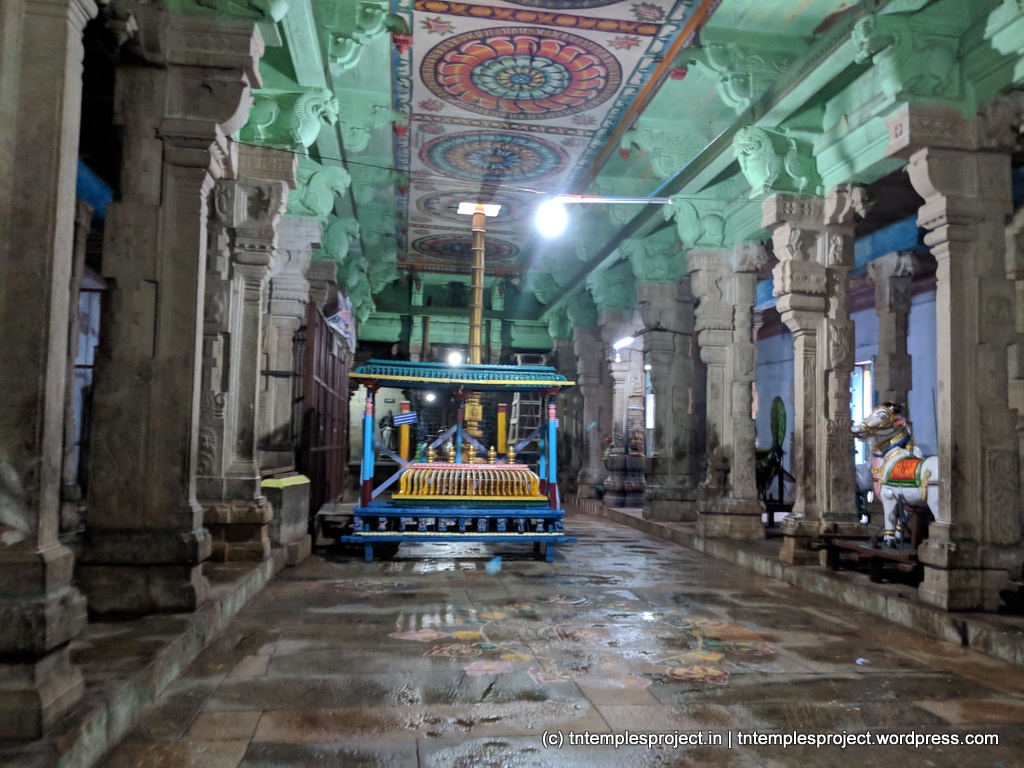Basic information about the temple
| Moolavar: | Pushpavaneswarar | Ambal / Thayar: | Soundaravalli |
| Deity: | Siva | Historical name: | Tiruppoovanam |
| Vriksham: | Pala | Teertham: | Vaigai, MaNikarNikai Teertham, Vasishta Teertham, Indra Teertham |
| Agamam: | Age (years): | Timing: | 6 to 11 & 4 to 8 | Parikaram: |
| Temple group: | Paadal Petra Sthalam (Pandya Nadu) | – | |
| Sung by: | Temple set: | ||
| Navagraham: | Nakshatram: | ||
| City / town: | Tirupuvanam | District: | Sivaganga |
| Maps from (click): | Current location | Sivaganga (22 km) | Madurai (24 km) |
| Virudhunagar (53 km) | Karaikudi (79 km) |
Location
Sthala puranam and temple information

During the Puranic times, Dharma Yagnan of Kasi was carrying his late father’s ashes to Rameswaram, to immerse them in the sea water there. On the way, he and his friend stopped here. At some point during their stop, the friend opened the urn, but found a flower instead of the ashes. Surprised by this, he did not reveal the fact to Dharma Yagnan. When they reached Rameswaram, they found only ashes in the urn. Even more surprised, the friend revealed what he had seen at Tirupuvanam, and so the two came back here, and found that the ashes had indeed become a flower once again. So they immersed the contents of the urn in the nearby Vaigai river. Due to this sthala puranam, this place is considered holier than Kasi.
Not to be confused with Tribhuvanam near Kumbakonam, Tirupuvanam or Tirupoovanam used to be a forest of flowering trees, and hence the name. The temple is located on the banks of the Vaigai river. At one time, there were forts and temples in the four corners of the town, and this temple was one of them, as can be seen in the moat and the remnants of a fort-like structure in the vicinity of the temple. In olden times, this place had various names including Pushpavanakasi, Lakshmipuram, Brahmapuram, Bhaskarapuram, Rasavadapuram and Pitrumokshapuram.
This temple is the site of one of the 64 Tiruvilaiyadals (divine plays) of Siva, and appears in the Koodal Kandam of that puranam authored by Paranjothi Munivar. Ponnaiyal, a dancer girl and a staunch Siva devotee, had an ambition to make a murti of Siva out of gold. But she was unable to do so due to lack of funds. Pleased by her devotion, Siva appeared in the form of a craftsman / alchemist named Rasavata, and instructed her to melt all the metals at her home – which were only iron and brass. An unbelieving Ponnaiyal did so, and found that overnight, the molten lump had turned into gold. Rasavata then sculpted the murti out of it. Ponnaiyal was so taken by the beauty of the murti, that she pinched its cheeks, leaving behind her nail marks on it! This murti is the utsava murti of this temple even today.
As Sati, Parvati had incurred a sin for having fought with her father Daksha, at his yagam. To expiate this sin, She worshipped Siva here, who appeared to Her under a Parijata tree. The moolavar Lingam is said to be a swayambhu murti, worshipped in the past by various celestials including Vishnu, Brahma, Suryan, Chandran, Yama and Nala. The garbhagriham also has a separate murti of Siva with three faces.
The Padma Puranam tells the story of Sage Agastyar who drank up the oceans, to expose the asuras who had hidden there. It is also said as part of the sthala puranam here, that the sage first drank the water from the Manikarnika Teertham of this temple, which enabled him to drink up the entire ocean water.

This is one of the few temples where the Tevaram moovar – Appar, Sambandar and Sundarar – have all sung pathigams. It is said that the entire area surrounding the temple, up to the Vaigai river, was covered in Siva Lingams and so Appar stood on the opposite bank of the river and sang their pathigams from there. When Sambandar visited here, the Nandi was in the line of axis from where Sambandar was, and so it is said that Siva asked Nandi to move a little. Even today, Nandi can be seen slightly misaligned to the axial line from the garbhagriham.
The temple would have existed in the 7th century, given that Sambandar has sung a pathigam here. However, the structural temple is clearly Chola, from across two centuries. The core temple is from the late 9th / early 10th century, built in the time of Aditya Chola I, while subsequent additions funded by Sembian Madevi are referred to in the inscriptions in the temple. These inscriptions also refer to various endowments from Aditya Chola for lighting of the temple’s lamps, and also to Uttama Chola’s grants for maintenance of this temple as well as the nearby Perumal temple. In recent times, the temple has been maintained and refurbished by the Nagarathar community.
The temple has five separate Teerthams, including the Vaigai river. There is an incomplete mandapam in the temple, as well as a separate shrine for Madapuram Kali Amman at the entrance to the temple. Soundaranayaki Amman’s shrine is to the right of the main garbhagriham, representing the kalyana kolam of Siva and Parvati. The main garbhagriham itself is square shaped, while the vimanam is six-sided.
Other information for your visit
Contact
Phone: 04575-265082; 94435 01761
Gallery




























